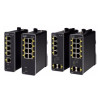Support for Enhanced CIP Identity and other new feature
New Features
- Support for Enhanced CIP Identity—Additional CIP ID object attributes are supported for automatic registration and verifying product warranty and authenticity.
- The Vendor Specific Attributes (VSAs) added for CIP Identity include Catalog number, Manufacture Date, Hardware Revision, Hardware Series, and Cisco serial number.
- Support for password length up to 63 characters.
Software Features
Smartports Macros
- Smartports macros provide port configurations that customer can manually apply based on the device connected to the port.
Port Mirroring
- Port mirroring copies traffic from a source port on the switch to a destination port on the same switch for analysis.
Error Disable Event
- If a specific error occurs on a port, the switch automatically disables the port so that it does not send or receive traffic. Supported error events are link flap and DHCP rate limit.
Storm Control
- Provides configuration of storm control policer rate to prevent LAN ports from being disrupted by excessive traffic.
Syslog
- Syslog displays a record of events that occurred on the device and its ports. Syslog entries can be viewed on the Web GUI or forwarded to a remote syslog server.
Common Industrial Protocol (CIP)
- CIP is an industrial control protocol. It provides a comprehensive suite of messages and services for the collection of industrial automation applications. The IE 1000 natively supports CIP without any configuration needed. It passed ODVA CIP conformance testing and can be integrated into an industrial automation environment.
Web GUI interface only
- Through a user-friendly web device manager, the Cisco IE 1000 provides easy out-of-the-box configuration and simplified operational manageability to deliver advanced and secure industrial networks.
BPDU Guard
- The STP PortFast BPDU guard enhancement allows network designers to enforce the STP domain borders and keep the active topology predictable. The devices behind the ports that have STP PortFast enabled are not able to influence the STP topology. At the reception of BPDUs, the BPDU guard operation disables the port that has PortFast configured. The BPDU guard transitions the port into errdisable state, and a message appears on the console.
DHCP Server
- The DHCP Server feature is a full DHCP Server implementation that assigns and manages IP addresses from specified address pools within the switch to DHCP clients.
Ether Channel LACP
- Link Aggregation Control Protocol (LACP) allows the creation of Ethernet channeling with devices that conform to IEEE 802.3ad.
IGMP
- IGMP is an IPv4 protocol that a host uses to request multicast data for a particular group. Using the information obtained through IGMP, the software maintains a list of multicast group or channel memberships on a per-interface basis. The systems that receive these IGMP packets send multicast data that they receive for requested groups or channels out the network segment of the known receivers.
HTTP/HTTPs, SSH, and Telnet
- The Cisco IE 1000 Switch provides connectivity via HTTP/HTTPs, SSH and Telnet.
MST spanning tree mode
- MST maps multiple VLANs into a spanning tree instance, with each instance having a spanning tree topology independent of other spanning tree instances. This architecture provides multiple forwarding paths for data traffic, enables load balancing, and reduces the number of STP instances required to support a large number of VLANs. MST improves the fault tolerance of the network because a failure in one instance (forwarding path) does not affect other instances (forwarding paths).
- MST provides rapid convergence through explicit handshaking as each MST instance uses the IEEE 802.1w standard, which eliminates the 802.1D forwarding delay and quickly transitions root bridge ports and designated ports to the forwarding state.
QOS Priority port
- The Priority Port feature allows the end user to specify a port which is connected to high priority end devices (eg: IP phone, or PLC), as a Priority Port. Once the Priority Port is configured, all the Ethernet packets received from that end device will have higher priority than packets received from other end devices connected to the IE1000.
Port-security
- Port Security limits the number of users on a given port. A user is identified by a MAC address and VLAN ID. If Port Security is enabled on a port, only the specified maximum number of users are allowed on the port. If this number is exceeded, an action is taken (described below). Port Security works together with MAC address learning to restrict access to a port.
STP port fast
- Port Fast immediately brings an interface configured as an access or trunk port to the forwarding state from a blocking state, bypassing the listening and learning states.
- You can use Port Fast on interfaces connected to a single end device or server, to allow those devices to immediately connect to the network, rather than waiting for the spanning tree to converge.
- Interfaces connected to a single end device or server should not receive bridge protocol data units (BPDUs). An interface with Port Fast enabled goes through the normal cycle of spanning-tree status changes when the switch is restarted.
Virtual LAN (VLAN)
- A VLAN is a group of devices on one or more LANs that are configured to communicate as if they were attached to the same wire, when in fact they are located on a number of different LAN segments. Because VLANs are based on logical instead of physical connections, they are extremely flexible.
- VLANs define broadcast domains in a Layer 2 network. A broadcast domain is the set of all devices that will receive broadcast frames originating from any device within the set. Broadcast domains are typically bounded by routers because routers do not forward broadcast frames. Layer 2 switches create broadcast domains based on the configuration of the switch. Switches are multiport bridges that allow you to create multiple broadcast domains. Each broadcast domain is like a distinct virtual bridge within a switch.
Alarm
- The switch software monitors switch conditions on a per port or a switch basis. If the conditions present on the switch or a port do not match the set parameters, the switch software triggers an alarm or a system message.
- The Cisco IE 1000 PoE(+) switches have one external alarm port and support one output relay.


